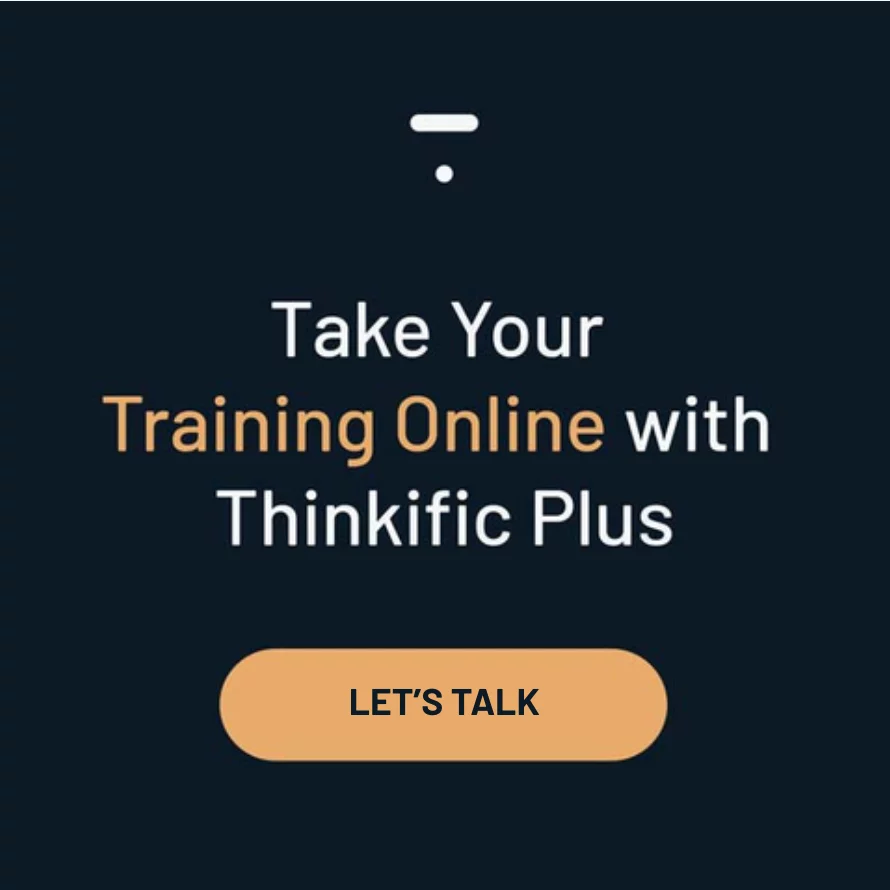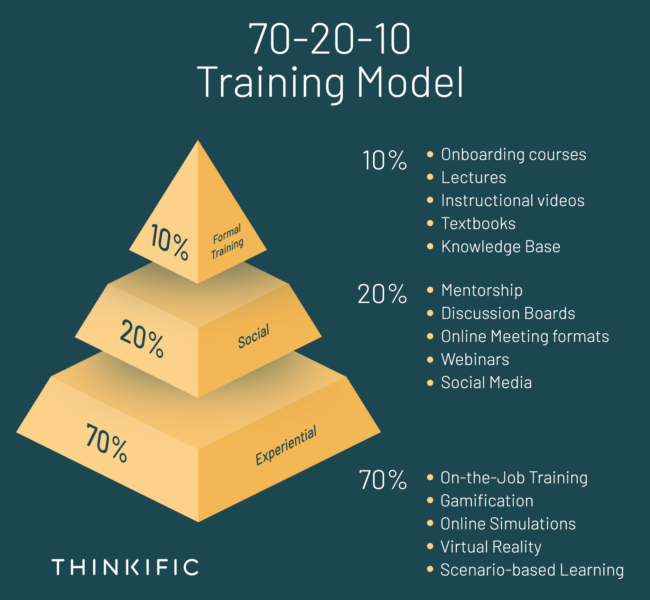Online and e-learning are taking off as people settle in for the long haul of remote working and distance learning environments. Which means businesses are investing in digital learning tools and platforms like never before.
JPMorgan Chase is planning to spend $600 million to upskill its workforce. Amazon is investing over $700 million to provide upskilling training to their employees. And, PwC is spending $3 billion to upskill all employees over the next three to four years.
If you’re exploring a new, more flexible learning management system (LMS) that will create engaging learning experiences, you’ll need an LMS implementation project plan that helps you build, launch, and maintain a successful platform.
In this article, you’ll learn everything you need to know to create a streamlined LMS implementation project plan, like:
- A quick reminder of what a learning management system is
- How to select the right tool for your business (with a downloadable guide!)
- Benefits of an LMS implementation project plan
- Pre-, during, and post-launch steps for your LMS implementation (with a downloadable launch preparedness checklist!)
What is a learning management system (LMS)?
Before digging into the LMS implementation project plan, it’s helpful to start at the top. What is a learning management system?
LMS’ are powerful tools when used correctly. An LMS is an e-learning tool that helps trainers create, upload, manage, distribute, and track their online training initiatives in one place. LMS’ are most frequently used for employee, customer, or channel partner training, as well as ongoing learning and lead generation.
Selecting the best fit LMS for your business
The prerequisite to any LMS implementation project plan is selecting the right tool for your business. In large part, this all comes down to aligning your needs and requirements with the tool’s capabilities.
When shopping around for LMS partners, ask yourself these questions:
- Can this tool handle our technical requirements?
- Is it flexible enough to meet our needs?
- How important will customer success be?
- Will it scale with our growth?
- Does it provide the user experience our students need?
These will get you off to a running start – but what will be most useful is a detailed evaluation guide that identifies exactly what you need to think about when doing your research. Download Thinkific Plus’ Evaluation Guide here to help you on your LMS selection journey.
Benefits of an LMS implementation project plan
Selecting an LMS is a feat in and of itself. It takes time, diligence, and many different vendor conversations to identify a system that is the best fit for your company’s needs. Once you have your LMS selected, there’s no question you’ll want to deliver ROI as quickly as possible – starting with your detailed LMS implementation project plan.
Here are a few benefits to creating a project plan that gets your system running quickly:
- Saves times. With a solid implementation plan, you’ll have your new system active much faster than when winging it after your purchase. It’ll save you time – and likely, a lot of headaches.
- Creates a seamless implementation. In mapping out your steps for a solid implementation, you’re already on the path to success. With a detailed plan, you can account for everything necessary to create as smooth an implementation as possible – for you and your users.
- Returns are generated quicker. IBM uncovered a $30 return for every $1 spent on e-learning. No matter how small or large, businesses will be looking to quickly reap the ROI for their LMS purchase. One of the fastest ways to get there is with a thoughtful implementation approach that creates immediate value for customers.
Pro tip: One of the benefits of our top-tier plan, Thinkific Plus, you’ll receive a dedicated one-on-one Customer Success Manager (CSM). From the moment you sign your Plus contract, your CSM will be there to support your business goals and act as your guide as you navigate the Thinkific Plus platform. This includes working with you to build a detailed implementation plan, create a feasible timeline with key milestones, and complete a Launch Preparedness Review to ensure you’re set up for success.
16 steps for a streamlined LMS implementation
Getting a new LMS launched and ready to deliver immediate value is no easy deed. But it doesn’t have to be overwhelming either.
With a detailed LMS implementation roll-out plan, you’ll have everything you need to guide you through the most critical stages:
- Pre-Launch
- During Launch
- Post-Launch
Pre-Launch Implementation Plan Steps
Mapping out a seamless LMS implementation starts as soon as you’ve selected your platform and enter your pre-launch stage. Below are our suggested steps in getting your LMS implementation off to a successful start.
1. Align your stakeholders
Aligning your stakeholders is the first step for a reason. Your stakeholders can make or break your successful LMS implementation. When aligning your stakeholders, it’s important to identify:
- Implementation stakeholders (your launch team)
- Internal stakeholders (anyone within your company the LMS is meant to provide value to)
- External stakeholders (any external parties that could influence your plan, such as the LMS Support team, web developers, instructors or content creators, designers, and more)
From an internal lens, it’s also important to probe managers for any onboarding hiccups they have and get a solid understanding of their training and development goals.
Once you’ve aligned your stakeholders, you’re ready to build your team that will help you create the system of your dreams. You can start by making sure everyone knows their roles. The RACI matrix is a helpful way of assigning roles by defining who is responsible, accountable, consulted, and informed across every stage of the project plan.
2. Set a timeline (and live by it!)
After identifying your key stakeholders, you’re ready to set a project timeline that works for everyone involved. One way to do this is by working backward from your desired launch date. Keep that date in mind while also thinking through and outlining every major milestone you’ll need to achieve to meet your deadline – and then assign your milestones with a deadline. Gantt charts are a visual way to display your timeline so everyone can see every milestone that stacks up to the launch date.
Pro tip: Make sure the timelines work for everyone’s schedule and that your project isn’t competing with other major initiatives that could take their focus away.
3. Invest in a training needs analysis
A training needs analysis will help you understand the job your LMS needs to do – and what gaps it needs to close. With a training needs analysis, you can map out the transformation your students need to make to transition from their current reality to their desired future.
The first step is to assess your audience’s specific needs based on skill expectations for certain groups with a training needs analysis. To do this, you can break out your internal groups by the categories below and assign specific skills or technical knowledge an individual needs to succeed in that group:
- Job Role
- Department
- Organizational Level
Then, you need to identify the gaps between the skills your employees currently have and the ones they need to develop to get to where they need or want to be. And that gap knowledge will help you create a content roadmap for your LMS implementation later on.
4. Get your content ducks in a row
At this point, you’ve created your team, set your deadline, and identified the training gaps your LMS is meant to correct. Now, you’re ready for the content itself – which can be integrated in a couple of different ways.
First, you can import your existing learning content directly into your LMS platform to get up and running faster. At Thinkific, we have the Bulk Importer capability that enables you to upload all of your course’s video, audio, and PDF lessons with a simple drag and drop. This makes the course migration process a lot less scary! On a Thinkific Plus plan, your dedicated Customer Success Manager (CSM) can advise on custom migration as well.
Or, you can develop your course content from scratch. If you’re taking this route, we suggest starting with a content outline and integrating the engaging capabilities your new LMS offers – such as quizzes, surveys, and discussion boards. But remember, this process can take time, so make sure to carve out the right amount of time dedication in your LMS implementation project plan and timeline.
Related Article: Check out more tips and tricks for creating engaging course content!
5. Train your users on the system
An LMS is a powerful learning tool if people know how to use it. So, it’s important to ensure your users know how to access and use the system before letting them loose.
Start by briefing new users on how to log in and navigate the system to access their training materials. You can also double-check with managers to make sure they understand the system and their role in running it to help develop their team members.
Pro tip: A simple training manual and easily accessible FAQ can save you a lot of time answering basic questions like “What is my login?” or “Which training should I do first?”
6. Don’t forget about user experience
User experience is essential to capturing your students’ attention and getting them excited to use your new LMS. It’s important to weave user experience throughout the pre-launch stage so that when it comes to launch time, you know your platform is easy to navigate from start to finish.
Need inspiration for creating a memorable user experience? Consider integrating learning experience design (LXD) into your curriculum-building approach. LXD is the intersection of instructional design and user experience design that incorporates everything from a user-centric approach to hands-on learning concepts.
When you’re ready to test your user experience, add a beta user and assign them training content. Make sure they get the welcome email and that it’s not going to spam. Log in as them to ensure that it works as expected and that they were assigned the correct training content.
7. Test, test, and test again
Few things are more frustrating than working hard to launch a system, only to find out that something’s not working the way you wanted it to. Which is why we believe in the power of testing before a launch.
Don’t forget to test the compatibility of your system while you’re in test mode. Try a few different web browsers, like Safari, Chrome, Firefox, and Internet Explorer.
8. Triple-check your launch preparedness
At this final step, you’ve put in the work, dedication, and time to get your LMS off the ground successfully – and are likely anxious to get it out to the masses. But, before hitting the ‘go’ button, it never hurts to double- and triple-check your system’s preparedness for its launch.
Download Thinkific’s launch preparedness checklist to ensure you have everything in place before you launch your new system.
Implementation Steps During Your Launch
Now that your LMS is officially launched, there are several steps you can take to maintain your system, so it performs to the height of its abilities.
9. Take stock of your content
With your LMS implementation already underway, now is the time to do a pulse check of your content. What other content or courses do you need? What courses are going over well, and which ones are students struggling with?
Additionally, you can take steps to elevate your courses’ engagement by layering quizzes, evaluations, and certificates your students can share broadly.
10. Organize your curriculum
As you continue to hammer out your content approach, which is an ongoing process, you can also take time to ensure your content’s organization is on par with your audiences’ needs.
When doing this, remember to review your course’s categories and sections, as well as navigation. These ensure your user experience is as informative as it is engaging.
11. Individual course review
After taking a look at the big picture, you can now focus on taking your revisions course by course.
Is your curriculum connecting with students and enabling them the way they need? Are there any prerequisites to the courses your audiences would find helpful in setting them up for success? Does the course’s completion leave them wanting more?
These are critical guiding questions to consider as you take your courses up a level and ensure your LMS consistently delivers value.
Pro tip: On Thinkific, you can enable course reviews directly within your course curriculum to easily capture your students’ feedback. Or create a survey lesson type to ask specific questions about your course content.
12. Activate student support channels
Not all of your audience members are going to want to go at their training alone. They’ll have questions or want to collaborate with others taking the same course. Which is why integrating student support channels throughout your curriculum is important for keeping students engaged and inspired.
Those channels could be:
- Discussion forums where students can post questions
- Course admins that can answer questions
- Student communities where users can collaborate
Learn more about improving the student experience on Thinkific here.
13. Elevate your site branding
Course branding and customization are excellent tools to connect your students with your company at every step of the learning experience. And, with the right LMS tool, you can personalize your course with your own branded themes, logos, colors, and fonts, as well as customized interfaces, navigation, headers, and footers that will resonate with your students. Learn more about Thinkific’s branding options here.
14. Communicate with your students and instructors
Keeping students engaged well after your launch is an art form that requires a little bit of resiliency and a lot of automated support. Particularly with students, the more you communicate with them, the better – which is why student emails and drip campaigns can are massive value-adds to any LMS.
Drip campaigns are a common marketing tactic that involves sending a staggering series of emails to students who are slipping away from your courses. The logic here, to re-engage someone with their online education experience when they’ve fallen off.
Instructors also benefit from frequent communication, specifically through notifications. With Thinkific, instructors can opt-in to as many communications and notifications as they want. No matter if a new student or lead signs up for their course or there’s a new discussion post – the instructor can stay in the know at all times.
Post-Launch Implementation Steps
Moving into the post-launch stage of your LMS implementation project plan is a celebration! That means you’ve successfully pre-planned and launched your new platform – but the work doesn’t stop yet.
These post-launch implementation steps will help you stay on top of your system so you can make the necessary improvements that create stellar online education experiences.
15. Monitor system usage
Digging into your system’s analytics can tell you all kinds of stories, such as:
- Who is using your system
- How often they are using it
- Which courses are most and least popular
- How your students and progressing within individual courses
- Where you can make improvements
There’s much more to uncover with data and analytics, but at the heart of it, it can also tell you how successful your LMS implementation was and how you can improve future iterations of it. Discover Thinkific’s reporting capabilities here.
16. Ask for feedback
While this may be the last step in your LMS implementation project plan, it’s arguably the most important for the ongoing success of your system and online learning program. Getting direct feedback from your system’s users will help you understand exactly what’s working, what’s not, and where you can make improvements.
One way to deliver a top-notch student experience that keeps them coming back is by integrating Typeform with your Thinkific system to gather feedback.
No matter your method, just remember to ask. That way, you know exactly how people perceive your system and can define the value it provides them.
Conclusion
By now, I hope you have a good understanding of what it takes to develop a successful LMS implementation project plan that adds true value to your business. With a detailed plan, the right team, and the best-fit platform, you’ll be ready in no time to launch a system that gets your users and company where it wants to be.
If you’re ready to start exploring LMS options, give Thinkific a try today! Or, if you’re part of a larger organization that needs a flexible system that will grow with you, book a call to learn more about Thinkific Plus.






